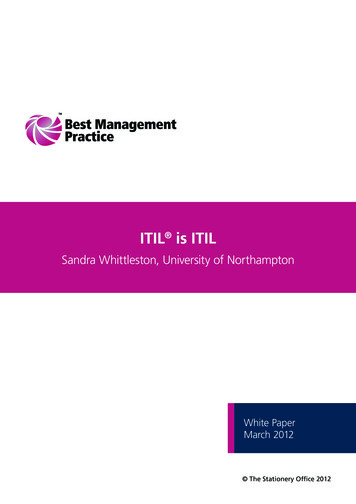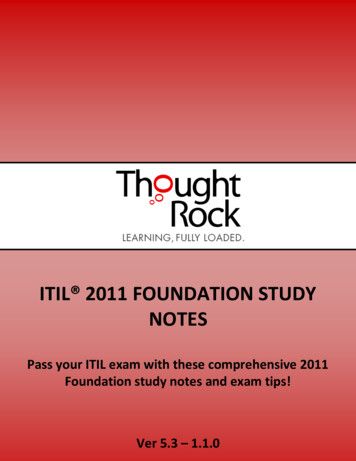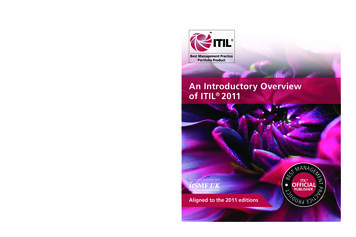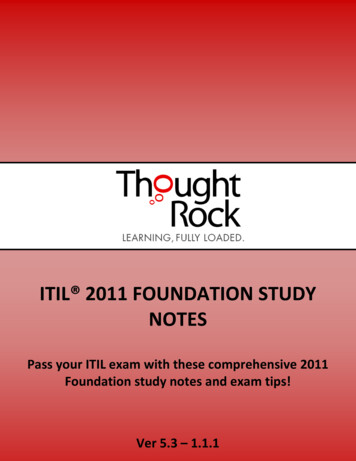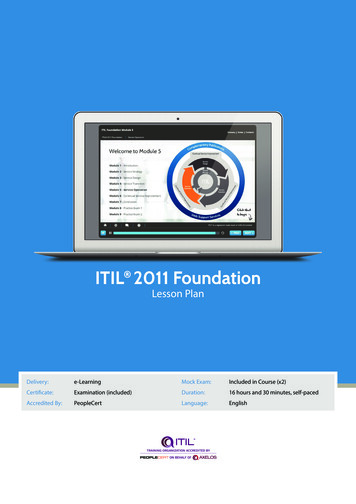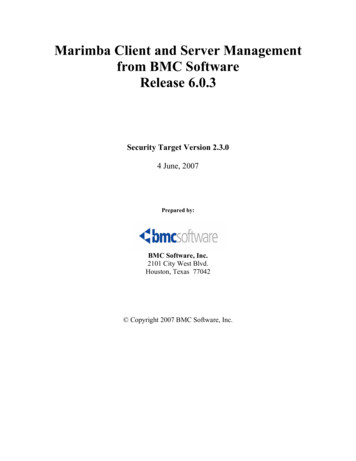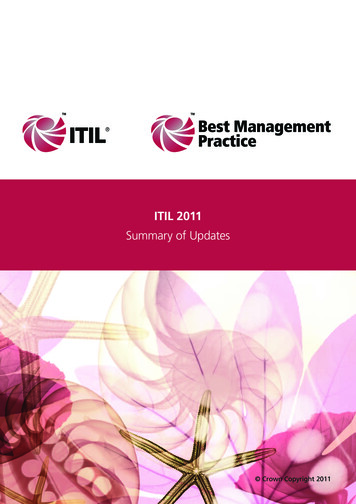
Transcription
ITIL 2011Summary of Updates CrownCopyright20112011 CrownCopyright
2ITIL 2011 Summary of UpdatesContents1Introduction32Global changes33ITIL Service Strategy44ITIL Service Design55ITIL Service Transition56ITIL Service Operation67 ITIL Continual Service Improvement78ITIL glossary89Continual improvement8Acknowledgements8Trademarks8Further information8 Crown Copyright 2011
ITIL 2011 Summary of Updates1IntroductionAs outlined in the Mandate for Change (September 2009) andthe Scope and Development Plan (February 2010), the ITILguidance has been updated in response to: Table 1 Summary of updates: globalArea of updateDescriptionChapter 1Chapter 1 (Introduction) containsgeneric content, which is the sameacross all five core publications.It provides an overview of thepublication, the context of thepublication in relation to the rest ofthe service lifecycle and best-practiceguidance, and, lastly, a discussionabout ITIL itself.Chapter 2Chapter 2, which looks at servicemanagement as a practice, is the samein each of the five core publications.Chapter 6Chapter 6 identifies the organizationalroles and responsibilities that shouldbe considered to manage each of thelifecycle stages (a stage per book)and the related practices. It includesgeneric roles, responsibilities andcompetencies that apply across theservice lifecycle, and specific aspectsfor the processes described in eachpublication.Lifecycle interfaces,and inputs andoutputs across theservice lifecycleA new table in Chapter 3 of eachpublication lists the inputs andoutputs of the lifecycle to which thepublication refers. Likewise a newappendix – Examples of inputs andoutputs across the service lifecycle –has been added to each publication.It contains a table which identifiessome of the major inputs and outputsbetween each stage to help usersunderstand how the different lifecyclestages interact.Related guidanceappendixThis new appendix – in each ofthe core publications – includesframeworks, best practices, standards,models and quality systems thatcomplement and have synergy withthe ITIL service lifecycle.RolesRoles have been made consistentacross the publications, ensuring thatactivities apply only to one role.Issues raised through the change control logAdvice from the change advisory boardFeedback from the training community.The project mandate was to correct errors, removeinconsistencies and improve clarity and structure. The updatedguidance also reflects the authoring team’s responses toreviewer feedback received during the first and second publicquality assurance reviews – with contributions from more than100 reviewers.Throughout the project, the authoring team have met regularlyto discuss any issues as they occur. Adhering to a strictgovernance structure, any significant issues raised by theauthoring team were escalated to the project board forassessment in their weekly meetings.This document outlines global changes made across the suiteand changes made specifically to the five core publications. Itwill provide you with a high-level overview of the updates thathave occurred as part of the ITIL update project.For a full list of all those that contributed to ITIL 2011 –including the authors, mentors and project board – please cationAcknowledgements.aspx2Global changesThe updated ITIL publications share a similar standard structure,to improve consistency and aid navigation. Some content hasbeen reorganized to improve flow and readability, and ensurealignment across the suite – including clarification aroundinterfaces, and inputs and outputs across the service lifecycle.Terminology has been clarified and made consistent across thepublications and the ITIL glossary.Table 1 documents global updates made to all of thelifecycle publications.3 Crown Copyright 2011
4ITIL 2011 Summary of UpdatesTable 1 continuedArea of updateOrganizationstructuresIt is now clear that organizationstructures given as examples areindicative rather then prescriptive.Structure ofprocessesAll processes have been givena common treatment, ensuringthat each one has purpose andobjectives; scope; value to business;policies, principles and basicconcepts; process activities, methodsand techniques; triggers, inputs,outputs and interfaces; informationmanagement; critical success factorsand key performance indicators; andchallenges and risks.Product managerAll references to product managerhave been replaced with serviceowner.CapitalizationExcessive and inconsistentcapitalization has been removed to aidreadability.3Area of updateDescriptionBusiness strategyand IT strategyBusiness strategy and IT strategyare two different things, and ITILService Strategy now describes theseseparately and explains the relationshipbetween the two: business strategydefines IT strategy, and IT strategysupports business strategy.Strategyassessment,generation andexecutionMore detailed guidance has beenincluded on how an organizationshould go about assessing, generatingand executing its IT strategy, givingpractical examples of how to proceed.Value creationGreater clarification is providedaround how services add and realizevalue. New text has been included todescribe how value is created, andhow to differentiate between valueadded and value realized. A newtable provides examples of utility andwarranty.CustomersIt is now clearer how customers differfrom users and consumers; howinternal and external customers aredifferentiated; how business units andother IT departments as customersdiffer; and how IT performs its role asan external service provider.Customer andservice assetsDefinitions of customer asset andservice asset have been clarified, withan explanation around why theseconcepts are important and how theyare used – including aligning serviceassets with customer outcomes. Anew series of diagrams demonstratesthe relationships between businessoutcomes, customer assets, serviceassets, constraints and servicemanagement.Strategymanagement for ITservicesThe newly defined process ofstrategy management for IT servicesis responsible for developing andmaintaining business and IT strategies.DescriptionITIL Service StrategyThe concepts within the publication have been clarified, withoutchanging the overall message. The updated publication includesmore practical guidance and more examples where relevant.The newly defined process of strategy management for ITservices is responsible for developing and maintaining businessand IT strategies, and there are now separate descriptions ofbusiness strategy and IT strategy. Financial management hasbeen expanded, and business relationship management anddemand management are now covered as processes.Table 2 Summary of updates: ITIL Service StrategyArea of updateDescriptionService strategyprocessesThe processes have now beenclearly named and defined: strategymanagement for IT services; serviceportfolio management; financialmanagement for IT services;demand management; and businessrelationship management. Eachprocess has been described using astandard template. Crown Copyright 2011
ITIL 2011 Summary of UpdatesTable 2 continuedArea of updateDescriptionFinancialmanagement for ITservicesThe financial management for ITservices process has been expandedto include some of the key elementsincluded in the earlier ITIL publicationswhich had been excluded in the 2007edition of Service Strategy – such asaccounting, budgeting and charging.BusinessrelationshipmanagementBusiness relationship management isnow covered as a process as well asa role. The differentiation betweenbusiness relationship management fora Type I, II and III service provider isbetter explained and clarified.GovernanceThere is now more detail ongovernance, including a fullerdefinition of what governance means,the difference between governanceand management, a governanceframework, and how servicemanagement relates to governance.Cloud computingTypes of servicemanagementimplementationOrganization4Some coverage has been addedon how IT service management isimpacted by the prevalence of cloudcomputing, and a new appendixhas been added specifically coveringservice strategy and the cloud:characteristics, types, types of service,and components of cloud architecture.Coverage has been added regardingthe types of service managementimplementation: even keel, trouble,growth and radical change.Some discussion on functions hasbeen added and a logical organizationstructure for service managementhas been included, with supportingdiagrams.ITIL Service Design5coordination’ process. Other significant clarifications include thefive aspects of service design, the design of the service portfolio,and the terminology related to views of the service catalogue.Table 3 Summary of updates: ITIL Service DesignArea of updateDescriptionFive aspects ofservice designThere is now consistency and clarityof references to the five aspects ofservice design.Transition of aservice frompipeline tocatalogue toretiredThe descriptions in the 2007 editionsof Service Strategy and Service Designwere unclear. In the 2011 edition, theyhave been updated to provide clarityon the definite transition points andthe places for policy setting. A newstatus has been added to make policysetting easier.DesigncoordinationprocessThe design coordination process hasbeen added to clarify the flow ofactivity in the service design lifecyclestage.Service catalogueterminologyThe service catalogue languagehas been revised with regard tothe customer’s view of the servicecatalogue, versus the technical or ITview.5ITIL Service TransitionThe structure, content and relationships of the configurationmanagement system (CMS) and service knowledgemanagement system (SKMS) have been clarified to help thereader to understand these key concepts.There is new content explaining how a change proposal shouldbe used. The evaluation process has been renamed ‘changeevaluation’ and the purpose and scope have been modified tohelp clarify when and how this process should be used.The service asset and configuration management process hasadditional content relating to asset management, and there areimprovements in the flow and integration of a number ofprocesses, including change management, release anddeployment management, and change evaluation.Throughout the updated ITIL Service Design publication,there has been particular focus on alignment with ITILService Strategy.A number of concepts and principles have been clarified, mostsignificantly the flow and management of activity throughoutthe overall service design stage with the addition of the ‘design Crown Copyright 2011
6ITIL 2011 Summary of UpdatesTable 4 Summary of changes: ITIL Service TransitionArea of updateDescriptionChangemanagementTop-level flowchart and sectionheadings have been modified so thatthey are consistent with each other.Change processmodelThe name ‘change model’ is now usedconsistently. Previously the descriptionused the term ‘change process model’but many places in Service Transitionand the other publications used‘change model’.Change proposalMore detail has been added to helpclarify how and when a changeproposal should be used.Configurationrecord,configuration item(CI), CMS, SKMSMany people were confused by thedescriptions of a configuration record,CI, CMS and SKMS in the 2007 editionof Service Transition and wanted aclear and unambiguous explanation ofthese concepts.EvaluationThe process name has been changedto ‘change evaluation’ and the purposeand scope have been clarified to showthat this process is used for evaluatingchanges only.Release anddeploymentmanagementSome sections have been reorderedand a high-level process diagram hasbeen provided showing how it all fitstogether.Service asset andconfigurationmanagementText has been added to explain theservice asset management aspectsbetter.6ITIL Service OperationProcess flows have been updated or added for allprocesses including request fulfilment, access managementand event management.Key principles – including guidance around service requests andrequest models, and proactive problem management – havebeen clarified. The publication has been updated to explainhow basic events flow into filters and rule engines to producemeaningful event information. The relationship betweenapplication management activities versus applicationdevelopment activities is also clarified.Other improvements include an expanded section on problemanalysis techniques, a procedure flow for incident matching,and further guidance for escalating incidents to problemmanagement. In addition, the guidance for managing physicalfacilities has been expanded.Table 5 Summary of updates: ITIL Service OperationArea of updateDescriptionService requestThe concept of a service request hasbeen significantly enhanced to providea clearer definition, with examplesand diagrams to illustrate how servicerequests link with the services theysupport. The relationship of servicerequests to request models andstandard changes is also highlighted.Request modelThis concept has been expandedto clarify how each service requestshould be linked to a request modelthat documents the steps and tasks,and the roles and responsibilitiesneeded to fulfil requests.Event filtering andcorrelationAdditional clarification has beenprovided to illustrate how basic eventsflow into filters and rule engines toproduce meaningful information.Normal serviceoperationA clearer definition for this has nowbeen included and added to theglossary.Incident matchingA procedure has been added toprovide examples of how incidentsshould initially be matched againstknown error records before escalation.A detailed procedure flow formatching incidents and escalating toproblem management has been added.Request fulfilmentprocess flowA new process flow now illustrates asuggested set of activities and stepsfor the request fulfilment process. Thisprocess flow also includes decisionpoints for escalating requests toservice transition as change proposalsor incident managemen
4 ITIL Service Design Throughout the updated ITIL Service Design publication, there has been particular focus on alignment with ITIL Service Strategy. A number of concepts and principles have been clarified, most significantly the flow and management of activity throughout the overall service design stage with the addition of the ‘design


